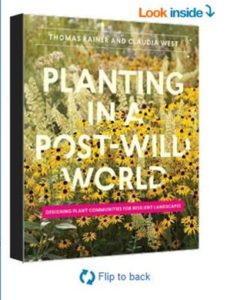Hello Fellow Readers, “Plant more plants” was music to my ears shared by Claudia West at a NJ Plants tradeshow held in Edison, NJ, a while back. Claudia is the Ecological Sales Representative of North Creek Nurseries, my go-to wholesale propagation nursery in Landenberg, PA. Her presentation was titled Planting in a Post-Wild World. She and Thomas Rainer co-authored a book with the same title in 2015. Her talk speaks about the importance of layering plant communities. To follow are tips on designing garden layers.
Layering plant communities to create a healthy environment.

Available on Amazon
Claudia described how to layer plant communities akin to those seen in nature to create a beautiful and healthy ecosystem. The Structural Layer is made up of “plants that have naked feet,” Claudia explained, which allows room for plants to thrive below. It comprises trees, shrubs, or large perennials that should cover no more than ten percent of the landscape. One of her favorite structural perennials is ‘Jeana’ Garden phlox (Phlox paniculata) which grows 4 to 5 feet. It has outstanding mildew resistance and fragrant lavender-pink flowers from mid-summer to early fall that are magnets for pollinators. Then there’s the stately Joe-Pye Weed (Eupatorium purpureum) with mauve-pink fluffy flowers in July through September atop deep burgundy stems.
Seasonal Theme Plants
The second layer, called Seasonal Theme Plants, creates a “strong color moment” each season that should consist of at least thirty percent of the landscape. Amongst nature, we see fields of glorious Goldenrod (Solidago) in fall or native Eastern Purple Coneflower (Echinacea purpurea) we have grown to love. It’s best to design using six to seven themes yearly, advises West. She shared the attributes of Blue Wood Aster (Aster cordifolius) with puffs of blue flowers in early fall, perfect for naturalizing under trees or along a woodland edge. Then there’s sun-loving Butterfly weed (Asclepias tuberosa) with bright orange flowers in mid-to-late summer that attracts butterflies, especially monarchs.
Plant more Plants!
I was dancing in the aisle when Claudia talked about the Groundcover Layer rather than using mulch. The Groundcover Layer occurs in the wild with waves of ferns, moss, and lichen on fields of rocks. Claudia touts a native “liriope alternative” Creek sedge (Carex amphibola). Then there’s Golden ragwort (Packera aurea) which is semi-evergreen. Its yellow daisy-like flowers spike up from the field of green and serve as a seasonal theme and a groundcover. I adore hearing an ecological expert advocating understory plants rather than the wasteful cycle of mulching.
Claudia wrapped up her presentation by sharing a picture from her native land of Eastern Germany, formerly destroyed by industry. Then a photo of the same scene after being restored with gorgeous blue water centered in a meadow of textures and colors. She explained that the transformation took place thanks to funding from the European Union and concluded, “Nature is resilient. We can make a difference.” Indeed, we can.
Garden Dilemmas? AskMaryStone@gmail.com and your favorite Podcast App.
Links to related stories you’ll enjoy: Native Plants for Native Pollinators, Butterfly Garden of Growth, and Native Plants, especially Oaks, are Essential.
There’s more to the story in Episode 75 of the Garden Dilemmas Podcast:

Landscape designed by Mary Stone, Stone Associates Landscape Design Consulting



